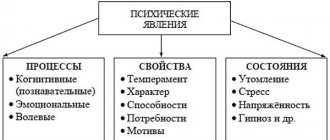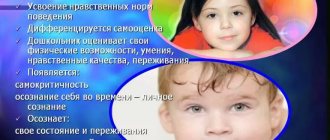Personal self-awareness is a person’s ability that helps to become aware of one’s own “I”, as well as one’s interests, needs, values, one’s behavior and experiences. All these elements interact with each other functionally and genetically, but do not evolve simultaneously. This skill arises at birth and is modified throughout human development. In modern psychology, there are three points of view on the origin of self-awareness, but one is traditional among all directions. This is an understanding of self-consciousness as the genetically original form of human consciousness.
The essence
Self-awareness is a complex mental process through which a person relates to his body, actions, evaluates personal feelings, experiences, and interests. Through it, the individual realizes his place in society. Self-awareness is a result of human development.
The development of self-awareness occurs in several stages:
- Up to a year. The baby learns to separate himself from the world and people around him. Cognition occurs through games.
- From 1 to 3 years. The child tries to perform different actions over time.
- From 3 to 7 years. The baby learns to talk about himself in the third person, trying to show his independence.
- From 7 to 12 years. The child is trying to adapt to society. This is facilitated by schooling.
- From 12 to 14. Children are interested in their own personality. The child tries to compare himself with adults.
- From 14 to 18 years old. Teenagers are trying to “find themselves” and influence their self-awareness.
As the child grows up, he learns:
- family values and norms;
- own image as a source of individual qualities and abilities;
- parental attitude expressed by emotional and cognitive assessments;
- self-esteem of parents and other close relatives;
- methods for regulating child behavior by adults.
What is self-awareness
Self-awareness is a certain attitude of a person towards himself, awareness of himself, his place, interests, experiences, behavior and others. This is not a given, but a result of development.
The source of the development of self-awareness is the generalization of a person’s knowledge about other people, comparison of their experiences with one’s own (life, professional, love). The more self-awareness develops, the more his inner world opens to a person.
Self-concept is the result of a person’s self-awareness, that is, a person’s theory about himself. Moreover, the self-concept can take more private forms, for example, being professional.
Functions and purposes
Goals:
- Cognition, experience of the inner world.
- Reflection of the world.
- Study of feelings, emotions.
- Overcoming psychological barriers and fears that prevent development and block certain areas of life.
The main function of self-awareness is to evaluate oneself from the outside, to study personal motives and the results of actions. Additional tasks:
- interpretation of experience;
- setting expectations;
- ensuring internal consistency;
- identifying personal boundaries.
Self-awareness must ensure the individual's conscious adaptation in relation to the environment. After studying personal characteristics, an individual can change to achieve the ideal. If an individual is mistaken about his qualities and actions, he will face difficulties and disappointments.
Types of social behavior
Social behavior is understood as a person’s behavior in society, which should influence him and those around him in general.
Social behavior is divided into types:
- helping;
- prosocial/asocial – the main motive for actions is goodness;
- deviant/deviant – illegal;
- group – common actions of a group of individuals;
- mass – the masses are active, but are not organized and do not have a specific task.
There are important types of social behavior that are associated with:
- uncertainty, self-confidence;
- the desire to achieve power, to be successful;
- a manifestation of humanism, enmity and friendship, evil and good.
Theories
The basis of the concept of self-awareness was formulated by Rubinstein. An individual, with the help of self-awareness, can understand himself, the structure of relationships with people, and perceive his personal environment.
According to Vygotsky's theory, a person begins to fully understand himself only at the end of adolescence. He connected this process with the ability to think and reflect.
According to Merlin's theory, the function of self-understanding consists of several components:
- Awareness of oneself as an object of activity.
- Understanding your own feelings and emotions.
- Identifying differences from other people.
Among the main criteria for assessing consciousness are:
- Isolation of the individual from the surrounding world.
- Awareness of the ability to control your actions, words, etc.
- Assessing the qualities of others, trying them on for yourself.
- Awareness of personal needs and motives for actions.
- Identifying and understanding your qualities.
Self-knowledge by means of knowledge of others
At first, the baby does not distinguish his person from the surrounding reality. However, over the course of three to eight months, he gradually distinguishes himself, his own body, among other objects that surround him in everyday reality. This process is presented as self-recognition, from which, in fact, self-knowledge begins. Adults are the main sources of a child’s knowledge about himself. Parents give the child a name, teach them to respond to calls, and so on.
An interesting expression of young children is “I myself.” It demonstrates their transition to the most important cognitive stage - a little person begins to use words to designate his own “I” and tries to characterize himself.
Knowledge of personality traits is carried out in the process of communication and performing various manipulations. When communicating, people evaluate and get to know each other well. Such assessments influence the self-esteem of any particular individual.
Levels
To determine one’s individual qualities, self-knowledge is carried out, which occurs through:
- self-observation of performance results;
- awareness of other people's assessment of one's actions;
- analysis of personal feelings and emotions.
With self-understanding, a person evaluates the world and the society in which he lives. The individual determines:
- style of existence;
- society values;
- morality;
- religiosity, spirituality.
When studying self-awareness, psychologists identify several levels of this mental process, which have certain characteristics. A person can accept the identified features as a given or try to change them.
Sensual
This is the lowest level. Sensation of psychosomatic processes occurring in the body together with experiences, feelings, emotions. Thanks to this, self-identification can be achieved.
Figurative-personal
A person’s awareness of himself as an active principle. Manifests itself through self-actualization and self-experience.
Analytical
The individual's awareness of the content of thought processes. Thanks to this, self-awareness and self-analysis are carried out. A person can observe behavior, feelings, emotions from the outside. Allows you to identify the main mistakes in behavior and select different tactics of action.
Active
This is a synthesis of three main levels - sensory, figurative-personal, analytical. Thanks to him, motivational functions are carried out.
Forms
Personal knowledge about oneself is a person’s system of ideas about himself, his mental and physical states. There are several forms of self-awareness.
According to the typology of V.V. Mironov forms of self-awareness are:
- Well-being. This is a person’s awareness of his body and its place, participation in the world.
- Self-identification. A person's identification with a social or cultural group.
- Personal knowledge about yourself. A person recognizes himself as someone similar to other people, but at the same time different from them. Along with this comes awareness of freedom of action and responsibility for them. Against this background, self-control and self-esteem come into play.
Sometimes these forms are called levels of human self-awareness. The first form is the lowest level, the third is the highest.
In addition to forms, it is customary in psychology to distinguish types or types of self-awareness:
- Public or social. This is a complex of collective beliefs and ideas about society during a certain period of time.
- Private. This is a person's awareness of certain aspects of himself. For example, when a subject looks in a mirror and sees his own face.
- Moral. This is a system of moral images and ideals to which a person strives.
All types are closely related to each other.
Structure
Self-awareness has a complex structure with many components that are responsible for performing different functions.
Self-understanding
Cognitive element. A person’s idea of their temperament, appearance, abilities, and talents.
Self-attitude
This includes self-directed criticism, assessment of personal capabilities, and self-control. They are assessed adequately. Manifests itself as selfishness and acceptance of all shortcomings.
Self-regulation
Desire for socialization. Any person wants to be recognized by society; he receives positive feedback from others regarding his hobbies. It is important for a person to gain a certain social status.
Self-actualization
Many experts consider self-actualization not one component of the structure of self-awareness, but something that is inextricably linked with it and develops together. Responsible for developing abilities to the maximum level. If there is a conflict, they can lead to self-destruction.
Self-esteem
With the help of self-esteem, a person can objectively assess strengths and capabilities, and distribute them to achieve a goal. Self-esteem can be underestimated or overestimated, which will affect the perception of personal abilities.
Claims
The level of self-esteem, which determines the possibility of achieving the set goal and the further development of the individual.
Mistakes in the development of self-awareness
If the crisis is not resolved correctly, then identification will be inadequate. We can distinguish the following variants of the abnormal development of self-awareness, which affect the individual and his relationships with the world:
- Avoidance of close interpersonal relationships.
- Fear of change and growing up, inadequate understanding of time, blurring of its boundaries.
- Wasting your own potential, productive and creative abilities. Inability to activate internal resources and concentrate on one activity.
- Refusal of self-determination and self-knowledge, selection of negative role models.
Separately, I would like to consider the option of developing an unfavorable self-concept, which is characterized by personal uncertainty, fear of rejection, and low self-esteem. This type of self-awareness is dangerous in the following ways:
- low self-esteem, which is reflected by social degradation, failure, aggressiveness, crime and asociality;
- reaction of adaptation in difficult situations, which is dangerous with the risk of being drawn into asocial groups and being influenced from outside;
- inadequate perception, which is reflected both in a person’s analysis of his actions or appearance, and in the analysis of external situations.
Other disorders in the development of self-awareness include:
- underdevelopment of self-awareness, that is, dependence on other people;
- distorted self-image;
- egocentrism (a distorted view of one’s role in the world);
- pathologies (mental disorders and diseases).
The structure of the self-concept
The main product of self-awareness is images of the Self. Basic:
- I'm fantastic.
- I am perfect.
- I am real.
Researchers divide them into groups developed by Sh. Samuel.
I am corporeal
Each person perceives their body differently. More often than not, the mental image is different from what the individual sees in the mirror. When forming a picture in the brain, signals coming from individual parts of the body are involved.
Real Me
A set of opinions about oneself at the present time. May not correspond to reality. It depends on the nature and presence of mental disorders.
Self-dynamic
An idea of yourself, but from the projection of an object that you want to become. Depends on social status, past successes, skills and talents. At the same time, the dynamic self can change when feelings of envy or greed arise.
I'm fantastic
This is an individual’s fantastic vision of a future in which everything has worked out according to his wishes. With age, the fantastic self is less clearly visible. It manifests itself most actively in adolescence.
Idealized self
A set of ideas about who you would like to see yourself now or in the future. Depends on the situation at a particular moment.
Self-represented
It includes images that a person puts on display in front of others in order to hide shortcomings and weaknesses. The self-represented is responsible for two functions - adaptation, protection.
The imagined self is similar to the ideal self. If they begin to differ greatly from each other, internal conflict occurs, which can lead to frustration.
I'm fake
It can be called self-deception of the individual. The pathological defense mechanisms of the personality depend on the false self.
Self-awareness in ontogenesis
In the previous paragraph, I already touched upon the connection between human development as a person and as an individual. In this part of the article I want to structure and summarize the development of self-awareness in combination with growing up.
Rudimentary self-awareness
Formed before the age of one year. Characterized by the child’s discovery of his Self.
Allopsychic self-awareness
Formed in 2-3 years. It is manifested by the child’s awareness of himself as an actor and the separation of his actions from the actions of other people.
Somatopsychic self-awareness
Formed by age 7. The child can independently evaluate himself, owns his body and undergoes bodily identification.
Autopsychic self-awareness
Adolescence and adolescence. It is assumed that by the age of 17, the formation of social and moral attitudes and self-awareness is completed. In the future, it does not develop, but changes.
Conclusion
At the end of this article, I would like to add that the full realization of one’s “I”: aspirations, desires, as well as other factors, is the final result that one must strive to achieve. It is necessary to realize that individuality is not bad - it is the norm. We don't have to be all random. With such success, including desire, we will simply begin the process of complete degradation of all humanity.
Only through individualization are we able to realize ourselves as individuals , trying on different images. Look for your unique style and path. Self-knowledge as a component of self-awareness helps us avoid cliches, open our “shell”, accept and love ourselves as we are. Remember how we previously described the influence of self-esteem on a person’s willingness to develop. Help yourself become a level higher in your aspirations, become a little better!











